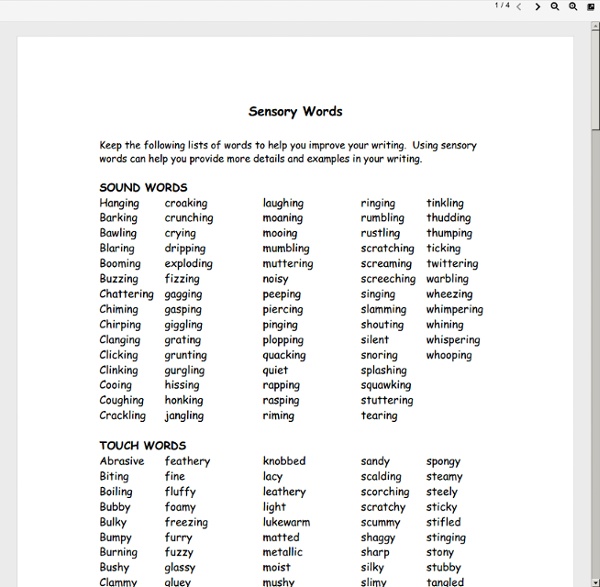



descriptive words chart 45 ways to avoid using the word 'very' Writers Write is your one-stop resource for writers. Use these 45 ways to avoid using the word ‘very’ to improve your writing. Good writers avoid peppering their writing with qualifiers like ‘very’ and ‘really’. They are known as padding or filler words and generally add little to your writing. According to Collins Dictionary: ‘Padding is unnecessary words or information used to make a piece of writing or a speech longer. Adding modifiers, qualifiers, and unnecessary adverbs and adjectives, weakens your writing. This post gives you 45 ways to avoid using the padding word ‘very’. Three Telling Quotes About ‘Very’ “Substitute ‘damn’ every time you’re inclined to write ‘very;’ your editor will delete it and the writing will be just as it should be. If you enjoyed this, you will love: Top Tip: If you want to learn how to write a book, sign up for our online course. by Amanda Patterson © Amanda Patterson
descriptive words 7 Steps for Writing a Novel in Scenes - Live Write Breathe You’ll notice I didn’t include the word “easy” in the title of this post. There are not seven “easy” steps to writing a novel in scenes. It takes hard work. Of course, when you’re not sure of the components that make up a scene, it’s harder to write one. Real Time: Even if you’re writing in third person using past-tense verbs, lay out actions in sequential order. Telling a cohesive story through scenes is an art that, once mastered, will breathe life into your writing. What are your tips for writing scenes? Need a good book to read? DawnSinger, Tales of Faeraven #1 by Janalyn Voigt A headstrong young princess and the guardian sworn to protect her fly on winged horses to the Gate of Life above the Well of Light in a desperate bid to release the DawnKing, and the salvation he offers, into a divided land. Purchase DawnSinger today! ©2013 by Janalyn Voigt
Fifteen Writing Exercises Writing exercises are a great way to increase your writing skills and generate new ideas. They give you perspective and help you break free from old patterns and crutches. To grow as a writer, you need to sometimes write without the expectation of publication or worry about who will read your work. Don’t fear imperfection. Pick ten people you know and write a one-sentence description for each of them.
Writing Characters Using Conflict & Backstory Seven Steps To Creating Characters That Write Themselves Creating characters that are believable takes time and discipline. Creating dynamically real individuals and not imposing your own thoughts and impressions upon them is not easy to do, and is often the difference between a novel or screenplay that sits in a closet and one that finds its way around town and into the hands of audiences. Spending your time building your characters before they enter the world of your story makes the process of writing an easier and more enjoyable ride, and creates a finished product that agents, publishers, producers and readers can truly be excited by. You must first agree to operate from the understanding that the three-dimensionality of your characters is not created magically. The complexity that you desire comes through: 1. The first key to deepening your work is finding the major motivators in the lives of your characters that drive their actions. 2. 3. 4. 5. Emotions are extreme. 6. 7.
Story Starters for Creative Writing Exercises One-line story starters are great for group writing exercises. They have enough conflict to start the writing flow, but are open-ended to allow each writer to follow his or her own direction. Individual writers can use them on a regular basis for “practice writing,” following Natalie Goldberg’s suggestions in Writing Down the Bones. Creative Writing Exercises Set a timer for 10, 15 or 20 minutes. As writing exercises for individuals, try doing one each day, or several a week if daily is too much. Develop a Short Story or Novel? If the results of these writing exercises remain intriguing, spend more time with them, either that session or on different days. Story Starters Here are 25 simple story starters to get the creative juices flowing.
Novel Writing Help Pictures and Images as Writing Prompts Can anyone think of a better way to start a new week than with a lovely picture writing prompts? I sure do love these type of writing prompts, they are quite possibly my favorites, because a picture can sometimes tell us so much more than words could. Words get misunderstood, but pictures cannot lie. Anyway, the idea with this kind of creative writing exercises is that you are given a picture to look at, which should inspire you to write a short story, poem or piece of flash fiction based on what you see in it, and what you can imagine is going on beyond the edges of it. The picture writing prompt: The instructions: Let the image above absorb you and let it tell you a story. Stay creative! Other creative writing picture prompts: Picture Prompts: Pictures That Tell a Story Picture Prompts: The Stairs to Somewhere Picture Prompts: The Door To Somewhere Picture Prompts: The World Beyond the Edge Picture Prompts: Something’s in the Air Picture Prompts: The Big House Picture Prompts: Wooden Bridge